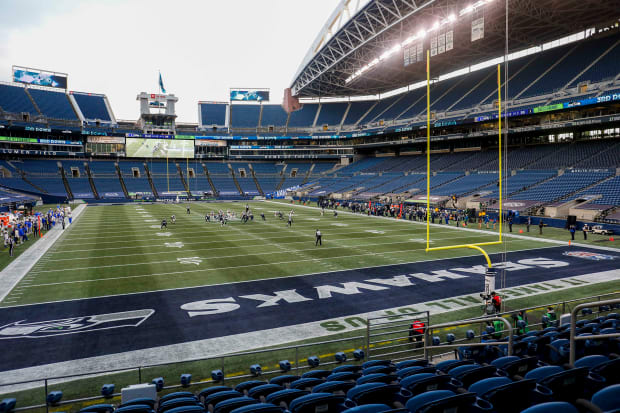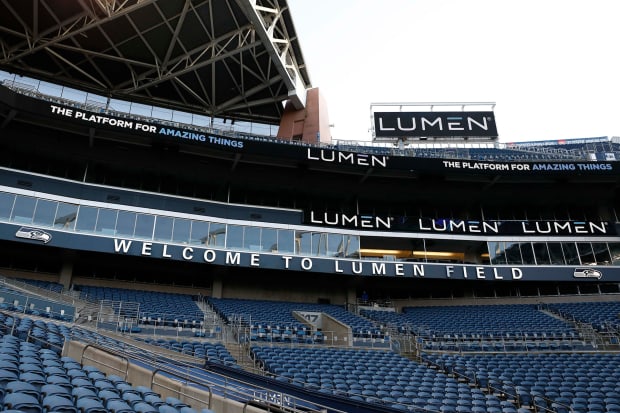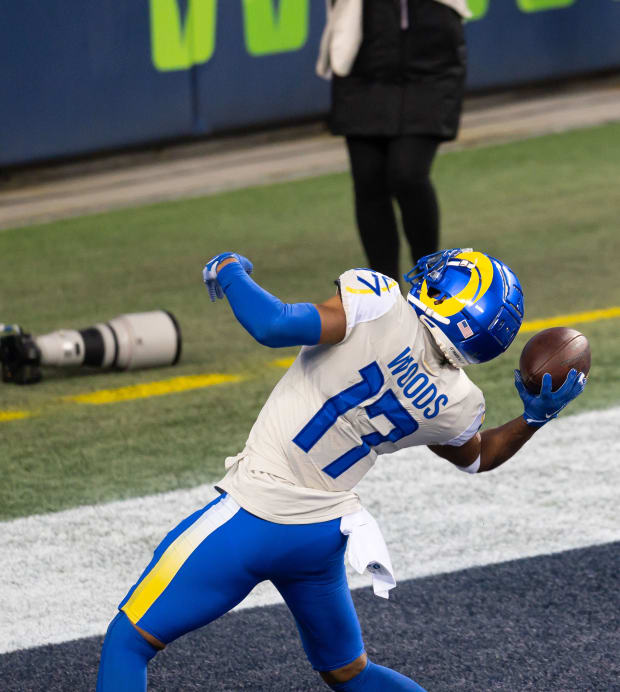The hum of an air conditioner. The rustling of leaves. A quiet whisper. Tracking the decibel levels for Seattle’s quiet playoff exit.
SEATTLE — Saturday morning felt familiar. This was January, after all, which meant the dawn of another NFL postseason, which meant the Seahawks, playoff entrants in eight of the past nine seasons, would host a game in their raucous, rowdy, bring-earplugs and leave-babies-at-home stadium near the downtown waterfront. In most years, cars would snake in lines around the side streets, parking lots would fill to capacity, revelers would pack into adjacent sports bars and the vendors on Occidental Avenue would peddle hot dogs laden with cream cheese and fries doused in garlic to the masses.
The best part of a setting unlike any in pro football? The sounds: vendors shouting, fans arguing, fireworks exploding, noise meters shooting skyward as murmurs became ovations and ovations became deafening roars, the mascot bird ca-cawing, chants of SEA-FENSE from the die-hards echoing, player introductions booming over loudspeakers. The sounds helped define the experience, allowing the 12s, as Seahawks fans call themselves collectively, to turn a stadium (now Lumen Field) into a football cacophony.
And yet, as the clock ticked toward 1:30 p.m. local time on Saturday, nothing about the scene felt normal, apart from Seattle’s team sprinting through the “home” tunnel onto the field. The sounds were gone, mostly, the vendor shacks on Occidental shuttered, the get-your-hot-dogs! muffled; the 12s at their respective homes, screaming at their televisions; the fireworks displayed on the Lumen big screens, rather than actually being set off. The pregame Seahawks hype video unspooled with no one to hype up beyond the home team’s sideline.
Normally, the insulated press box would begin to shake around then, as if withstanding a mild earthquake, while horns blasted and fans cupped their hands to amplify their jeers and fighter jets whooshed by overhead in a blink. Instead, only a handful of photographers patrolled the empty stands, and if they spoke, it was only to each other, from at least six feet away.

Anyone who spent Saturday afternoon watching a decibel meter on their computer from inside the press box at the mostly empty football stadium in Seattle could finally, fully understand just how loud the 12s can be. How loud they actually are. With them, decibel readings have registered above 136 at home games in recent seasons, comparable to standing next to a jet engine at takeoff or settling next to a speaker at the loudest-ever KISS concert.
As the national anthem hit all the peak notes (there, free, brave) and culminated to what normally would be raging, potentially hearing-damaging applause, the computer decibel reader never surpassed 64. That’s equivalent to a quiet suburb, a family conversation at the dinner table or the hum of an air conditioning unit from 100 feet away—all entrants listed in the “fairly quiet” category of noise according to various websites. Over the course of five and a half hours, from pregame warmups to the time the Seahawks finished stumbling against the Rams, the meter maxed at 72.3 decibels, and even when accounting for the sealed-off nature of the press box, the readings mostly hung in the 50-decibel range, meaning an NFL playoff game took place inside a “quiet suburb,” for comparison.
As Seahawks-Rams kicked off, the cheers were absent, the readings low. Both Rams defensive tackle Michael Brockers and wideout Cooper Kupp had returned from the COVID-19 reserve list. Quarterback John Wolford, who had placed his private equity career on hold and rose from an Alliance of American Football roster to become a capable backup for a playoff team and now a replacement for injured starter Jared Goff, loosened for his second-career NFL start, tossing footballs. Not a single person was there to jeer any of them (decibel reading: 53).
This scene repeated across the country, in stadiums that normally pack in as many fans as possible, tens of thousands clustered together in more normal times, all breathing the same air, high-fiving, embracing, the overflow spilling into nearby bars, streets and restaurants. Some franchises in states with more lax restrictions allowed fraction-of-capacity crowds, even while COVID-19 continued to spread across the world. The Seahawks did not have a choice. In Seattle, first-phase lockdown rules (no indoor dining, no indoor gatherings outside one’s household and, most relevant to Lumen Field, no crowds) had been put back in place in December.
The same week as Seahawks-Rams, The Ringer
explored an NFL season without crowds in a thoughtful piece that seemed particularly relevant to both the playoffs and the more distinct playoff settings (think: Seattle, Kansas City, Green Bay, New Orleans, Pittsburgh and, in other seasons, Foxboro). The story found a distinctly 2020 hiatus from home field advantage; in fact, home teams had lost one more game (128) than they won during this global pandemic season, an NFL first. That owed to factors beyond the lack of crowds—rhythm, comfort level, different sight lines in empty football palaces—but certainly no aspect impacted home teams more than the relative silence that greeted their opposition. And, in an opening playoff weekend with six games, the hosts won only two of them (Buffalo, New Orleans).This is what it sounded like for an Almost Silent Saturday in Seattle:
In the empty north parking lot, anyone standing close to the stadium could hear the flags flap on a windy, foggy afternoon.
Those parking in the Lumen Field garage encountered the sound of individual car doors shutting.

On the Rams’ first third down, when the 12s would normally attempt to fray their vocal cords, Seahawks rusher Carlos Dunlap pressured Wolford into an incompletion. Those perched above the field could see Seattle’s sideline erupt in applause, raising a question: If no one hears a sideline freakout, did it really happen?
On and on it went, this celebration of solitude, a football game unfolding in one of those Quiet Cars on an Amtrak train. Every time a referee announced a penalty over the stadium loudspeakers, the regular but amplified speech proved jarring. Some, like a 41-year-old sports writer jerked awake each time the official turned his mic on, wanted to reply, “Stop shouting at me!” after every holding call, when the decibel levels registered in the low 60s.
In general, the readings stayed low, except for whenever resident music czar, DJ SupaSam, sent snippets of tunes out over the stadium speakers. He served, essentially, as a one-man crowd. He danced. He waved his arms. He cheered on the Seahawks, albeit from underneath the 12th Man flag, hundreds of feet away, far above the field. Every time a play neared, SupaSam cut off the track, and decibel levels dropped back into the 35 range, registering as slightly above a whisper in the press box, where the most prominent sound was fingers tapping keyboards, or potato chips clanging against teeth—oh, the excitement! When the beats resumed, the readings kicked up into the 50s and 60s; the difference being the sound of music, as it were.
SupaSam started working with the Seahawks six seasons ago, and it took all of one game for him to describe the atmosphere as “unmatched.” Sometimes, the 12s thundered so loudly that he couldn’t hear his own music, even as it played over the speakers in the stadium. With that “vital” support gone, SupaSam entered this season hoping to bridge the gap between the absent fans and the players on the field. “I still wanted them to get hyped,” he says.
For the first game this season, SupaSam had to move from his usual field set-up to the second level above the south end zone, due to COVID-19 restrictions. From that vantage point, he stared out not at people but at row after row of empty seats. Having performed in front of crowds as large as 20,000, he tried to focus on the sideline, where the players’ body language, or their impromptu dancing, marked the DJ’s only feedback. Like the NFC West–winning Seahawks, the DJ persevered. Along the way, though, he came to even more fully appreciate the 12s. “You don’t fully miss a great thing until it’s gone,” he says.
The game lived down to the lack of energy in the stadium. Well, maybe not for the Rams players and coaches who pulled off the playoff upset with a decisive triumph. Wolford was hurt and sent to a nearby hospital. Goff played a game as gutsy as anything in his career with essentially four healthy fingers on his throwing hand. Defensive stalwart Aaron Donald spent so much time in proximity to Seahawks quarterback Russell Wilson it was like Wilson had personally invited him into the Seattle huddle. When Donald left the game with injured ribs, when Goff staked L.A. to a double-digit lead, when the Seahawks' season ended in a 30–20 defeat, they were all met with the same audible reaction—no noise at all, for the most part.
Now, in a normal season, six seismometers—instruments that measure the movement or vibration of the ground generated, typically, by earthquakes or volcanic eruptions— would have been set up at the stadium to record any “seismic signals.” These are not the same as decibel readings, but they speak to the same thing: a boisterous, eardrum-rattling crowd. The most famous example took place in the 2011 playoffs, when Marshawn Lynch rumbled through the Saints' defense and something known as the “Beast Quake” was born. Seismologists, like Jon Connolly of the Pacific Northwest Science Network, came back for every subsequent playoff game, and the 12s, with all their jumping up and down at pivotal moments, often turned a football stadium into an earthquake zone.
This year, PNSN did not post new readings on its Twitter page. Instead, as another playoff game approached, the company plastered a picture of the Beast Quake on its 10th anniversary and wished the Seahawks luck. Connolly watched the game from home, having not attended a Hawks affair in person this entire season. There had been no seismic signal at the stadium this year and, hence, no reason to measure for them. And while nobody associated with the team wants to say flat out that the Seahawks missed the 12s, that they might have at least performed better, or seized a victory in their playoff affair inside a sold-out stadium, Connolly does note that Seattle had won every playoff game that the company had been on hand to measure. “As a fan, I would say it has an impact,” he says.
The second half continued on Saturday, as the Seahawks fell behind and SupaSam laid down hits from the 90s and today. L.L. Cool J went on about mommas and knockouts as the Rams opened up their lead (51 decibels, comparable to a refrigerator’s hum). The meter surged (relatively) when Wilson scrambled for 17 yards (63 decibels, approximately the same as an electronic toothbrush). "Lose Yourself," from the 8 Mile soundtrack, didn’t even top 50 decibels, meaning mom’s spaghetti and vomit on one’s sweater went unnoticed to all but SupaSam.
The loudest sound heard inside the press box came from a local radio reporter who mildly shouted “Nice!” after a long, third-quarter Seattle kickoff return. This marked the opposite of normal, where there’s much cheering in the stands, but none voiced in the press box. By the time SupaSam played Naughty By Nature, it seemed fair to ask: hooray for what? "Thunderstruck," the AC/DC song created to burst eardrums, clocked in at 45 decibels. "Thunderstruck," a little quieter than the sound of moderate rainfall! And when the Rams won—when a football team accomplished something it worked toward for months—the meter actually fell to 19 inside the press box, a noise level comparable to rustling leaves.
On Saturday morning, the Seahawks had won 10 straight home playoff games in a setting as loud as anything in sports. This marked the third-longest such streak in NFL history, behind only the Packers (13) and the Patriots (11). By Saturday evening, Wilson had been battered, the Seahawks had been beaten and former NBA center Spencer Hawes, undoubtedly the tallest of 12s, had tweeted, “Kraken szn let’s go!!!”—referring to the city’s new hockey team. After half an hour, Seattle’s coach, Pete Carroll, stepped before a banner of team logos inside an entirely empty stadium. He didn’t make excuses. But he did, fairly and understandably, say, “We won a lot of playoff games with a raucous, wild, crazy fanbase.” Then, as if speaking directly to the 12s, he said, “Just wish we could have shared it with you.”

The Rams, meanwhile, will head to Lambeau Field this weekend for a Divisional Round game against the Packers. Fans will be in attendance, but not many, lessening an advantage that’s among the strongest in football. That bodes well for a defense that ranks among the NFL’s best, a quarterback with healing fingers and a team that will need to win every playoff game on the road to reach the Super Bowl. In a year absent any real, significant home field advantage, maybe L.A. is the right team for a championship game that will be held in Tampa with only a fraction of the fans compared to, well, any Super Bowl ever hosted since the NFL started printing its own billions.
Connolly and the seismologists plan to be back for the next home playoff game in Seattle—next season, they hope—with vaccinated 12s packed shoulder-to-neon-green-shoulder once again. “We’ll be hungry,” Connolly says. But not on Saturday, when the Seahawks trudged off their home turf into another off-season and all that could be heard were soft tones, melancholic music, like an emo vibe had been transported to Lumen Field. The man who played them, DJ SupaSam, wished to return to the same spot a year from now, where, in an ideal world, the home crowd would drown out whatever he chose to play.
And the decibel readings? Who needs hearing when the team advances deeper in the playoffs.





0 Comments